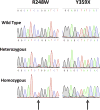A Sub-Type of Familial Pancreatic Cancer: Evidence and Implications of Loss-of-Function Polymorphisms in Indoleamine-2,3-Dioxygenase-2
- PMID: 29426021
- PMCID: PMC6047862
- DOI: 10.1016/j.jamcollsurg.2017.12.052
A Sub-Type of Familial Pancreatic Cancer: Evidence and Implications of Loss-of-Function Polymorphisms in Indoleamine-2,3-Dioxygenase-2
Abstract
Background: Variation in an individual's genetic status can impact the development of pancreatic ductal adenocarcinoma; however, the majority of familial pancreatic cancers (FPC) cannot yet be attributed to a specific inherited mutation. We present data suggesting a correlation between loss-of-function single nucleotide polymorphisms (SNPs) in an immune regulator gene, indoleamine-2,3-dioxygenase-2 (IDO2), and an increased risk of FPC.
Study design: Germline DNA from patients who underwent resection for pancreatic ductal adenocarcinoma (n = 79) was sequenced for the IDO2 SNPs R248W and Y359Stop. Genotypes resulting in inactivation of IDO2 (Y325X homozygous, R248W homozygous) were labeled as homozygous, and the other genotypes were grouped as wild-type or heterozygous. Genotype distributions of each SNP were analyzed for Hardy-Weinberg deviation. A genotype frequency set from the 1000 Genomes Project (n = 99) was used as a genetic control for genotype distribution comparisons.
Results: A significant 2-fold increase in the overall prevalence of the Y359Stop homozygous genotype compared with the expected Hardy-Weinberg equilibrium was noted (p < 0.05). Familial pancreatic cancer was noted in 15 cases (19%) and comparison of the FPC cohort set to the genetic control set showed a 3-fold increase in Y359Stop homozygous rates (p = 0.054). Overall in our cohort, the homozygous genotype group was associated with increased risk of FPC (odds ratio 5.4; 95% CI 1.6 to 17.6; p < 0.01). Sex, age at diagnosis, and history of tobacco use were not found to be significantly associated with FPC.
Conclusions: Our preliminary data suggest a strong association between the IDO2 inactivating Y359Stop SNP and an increased risk of FPC when compared with the control group. Future studies will evaluate the value of IDO2 genotyping as a prognostic, early detection marker for pancreatic ductal adenocarcinoma and a predictive marker for novel immune checkpoint therapies.
Copyright © 2018 The Authors. Published by Elsevier Inc. All rights reserved.
Figures



Comment in
-
Discussion.J Am Coll Surg. 2018 Apr;226(4):603-604. doi: 10.1016/j.jamcollsurg.2018.01.034. J Am Coll Surg. 2018. PMID: 29576161 No abstract available.
Similar articles
-
Host IDO2 Gene Status Influences Tumor Progression and Radiotherapy Response in KRAS-Driven Sporadic Pancreatic Cancers.Clin Cancer Res. 2019 Jan 15;25(2):724-734. doi: 10.1158/1078-0432.CCR-18-0814. Epub 2018 Sep 28. Clin Cancer Res. 2019. PMID: 30266763 Free PMC article.
-
Genotyping and expression analysis of IDO2 in human pancreatic cancer: a novel, active target.J Am Coll Surg. 2009 May;208(5):781-7; discussion 787-9. doi: 10.1016/j.jamcollsurg.2008.12.018. J Am Coll Surg. 2009. PMID: 19476837 Free PMC article.
-
Indoleamine-2,3-dioxygenase(IDO)2 polymorphisms are not associated with multiple sclerosis in Italians.J Neurol Sci. 2017 Jun 15;377:31-34. doi: 10.1016/j.jns.2017.03.048. Epub 2017 Mar 29. J Neurol Sci. 2017. PMID: 28477703
-
Progress report: familial pancreatic cancer.Fam Cancer. 2019 Jul;18(3):359-362. doi: 10.1007/s10689-019-00125-9. Fam Cancer. 2019. PMID: 30796632 Review.
-
Familial pancreatic cancer: Concept, management and issues.World J Gastroenterol. 2017 Feb 14;23(6):935-948. doi: 10.3748/wjg.v23.i6.935. World J Gastroenterol. 2017. PMID: 28246467 Free PMC article. Review.
Cited by
-
Genetic variants of the peroxisome proliferator-activated receptor (PPAR) signaling pathway genes and risk of pancreatic cancer.Mol Carcinog. 2020 Aug;59(8):930-939. doi: 10.1002/mc.23208. Epub 2020 May 5. Mol Carcinog. 2020. PMID: 32367578 Free PMC article.
-
Precious Data: Interim Report from the Jefferson Pancreas Tumor Registry.J Pancreat Cancer. 2018 Jun 1;4(1):17-24. doi: 10.1089/pancan.2018.0004. eCollection 2018. J Pancreat Cancer. 2018. PMID: 30631853 Free PMC article.
-
Inhibiting IDO pathways to treat cancer: lessons from the ECHO-301 trial and beyond.Semin Immunopathol. 2019 Jan;41(1):41-48. doi: 10.1007/s00281-018-0702-0. Epub 2018 Sep 10. Semin Immunopathol. 2019. PMID: 30203227 Review.
-
The Immunomodulatory Enzyme IDO2 Mediates Autoimmune Arthritis through a Nonenzymatic Mechanism.J Immunol. 2022 Feb 1;208(3):571-581. doi: 10.4049/jimmunol.2100705. Epub 2021 Dec 29. J Immunol. 2022. PMID: 34965962 Free PMC article.
-
Host IDO2 Gene Status Influences Tumor Progression and Radiotherapy Response in KRAS-Driven Sporadic Pancreatic Cancers.Clin Cancer Res. 2019 Jan 15;25(2):724-734. doi: 10.1158/1078-0432.CCR-18-0814. Epub 2018 Sep 28. Clin Cancer Res. 2019. PMID: 30266763 Free PMC article.
References
-
- Rahib L, Smith BD, Aizenberg R, et al. Projecting cancer incidence and deaths to 2030: the unexpected burden of thyroid, liver, and pancreas cancers in the United States. Cancer Res. 2014;74:2913–2921. - PubMed
-
- Yeo TP, Hruban RH, Brody J, et al. Assessment of “gene-environment” interaction in cases of familial and sporadic pancreatic cancer. J Gastrointest Surg. 2009;13:1487–1494. - PubMed
Publication types
MeSH terms
Substances
Grants and funding
LinkOut - more resources
Full Text Sources
Other Literature Sources
Medical

